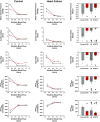Muscle metaboreflex stimulates the cardiac sympathetic afferent reflex causing positive feedback amplification of sympathetic activity: effect of heart failure
- PMID: 38009212
- PMCID: PMC11283898
- DOI: 10.1152/ajpregu.00235.2023
Muscle metaboreflex stimulates the cardiac sympathetic afferent reflex causing positive feedback amplification of sympathetic activity: effect of heart failure
Abstract
Exercise intolerance is a hallmark symptom of heart failure and to a large extent stems from reductions in cardiac output that occur due to the inherent ventricular dysfunction coupled with enhanced muscle metaboreflex-induced functional coronary vasoconstriction, which limits increases in coronary blood flow. This creates a further mismatch between O2 delivery and O2 demand, which may activate the cardiac sympathetic afferent reflex (CSAR), causing amplification of the already increased sympathetic activity in a positive-feedback fashion. We used our chronically instrumented conscious canine model to evaluate if chronic ablation of afferents responsible for the CSAR would attenuate the gain of muscle metaboreflex before and after induction of heart failure. After afferent ablation, the gain of the muscle metaboreflex control of mean arterial pressure was significantly reduced before (-239.5 ± 16 to -95.2 ± 8 mmHg/L/min) and after the induction of heart failure (-185.6 ± 14 to -95.7 ± 12 mmHg/L/min). Similar results were observed for the strength (gain) of muscle metaboreflex control of heart rate, cardiac output, and ventricular contractility. Thus, we conclude that the CSAR contributes significantly to the strength of the muscle metaboreflex in normal animals with heart failure serving as an effective positive-feedback amplifier thereby further increasing sympathetic activity.NEW & NOTEWORTHY The powerful pressor responses from the CSAR arise via O2 delivery versus O2 demand imbalance. Muscle metaboreflex activation (MMA) simultaneously elicits coronary vasoconstriction (which is augmented in heart failure) and profound increases in cardiac work thereby upsetting oxygen balance. Whether MMA activates the CSAR thereby amplifying MMA responses is unknown. We observed that removal of the CSAR afferents attenuated the strength of the muscle metaboreflex in normal and subjects with heart failure.
Keywords: TRPV1; cardiac sympathetic afferents; exercise; exercise pressor reflex; resiniferatoxin.
Conflict of interest statement
No conflicts of interest, financial or otherwise, are declared by the authors.
Figures


References
-
- Rowell LB, O'Leary DS, Kellogg DL Jr.. Integration of cardiovascular control systems in dynamic exercise. In: Handbook of Physiology, Exercise: Regulation and Integration of Multiple Systems. New York: Oxford Press, 1996, p. 770–838.
-
- O'Leary DS, Mueller PJ, Ja S-M, Sala-Mercado J. The Cardiovascular System: Design and Control. In: American College of Sports Medicine's Advanced Exercise Physiology Textbook, edited by Farrow P, and Joyner MJ.. Bethesda, MD: Lippincott Williams & Wilkins, 2011.
-
- Antunes-Correa LM, Nobre TS, Groehs RV, Alves MJ, Fernandes T, Couto GK, Rondon MU, Oliveira P, Lima M, Mathias W, Brum PC, Mady C, Almeida DR, Rossoni LV, Oliveira EM, Middlekauff HR, Negrao CE. Molecular basis for the improvement in muscle metaboreflex and mechanoreflex control in exercise-trained humans with chronic heart failure. Am J Physiol Heart Circ Physiol 307: H1655–H1666, 2014. doi:10.1152/ajpheart.00136.2014. - DOI - PMC - PubMed
Publication types
MeSH terms
Grants and funding
LinkOut - more resources
Full Text Sources
Medical

